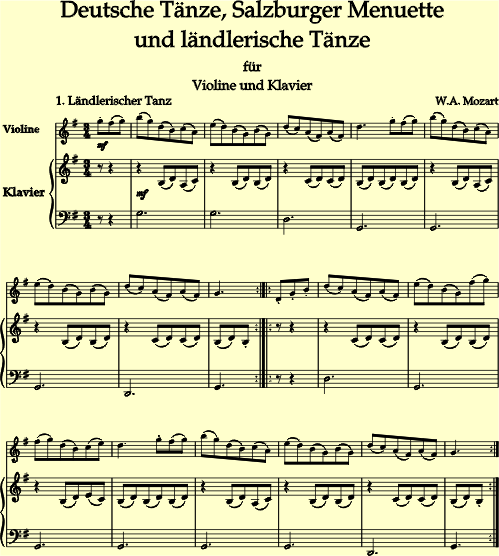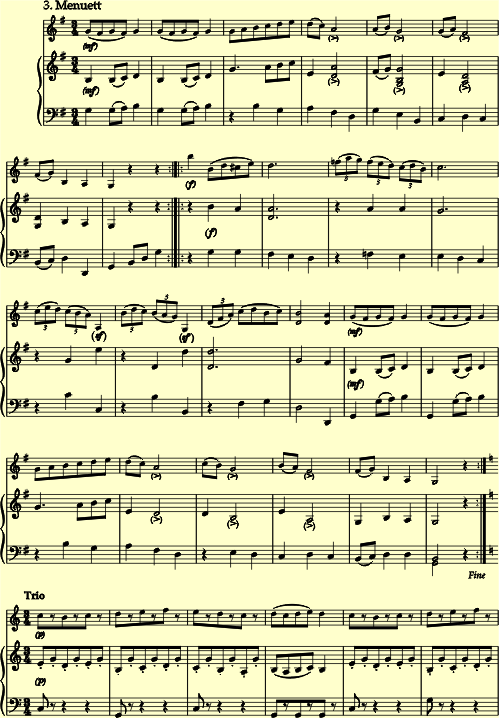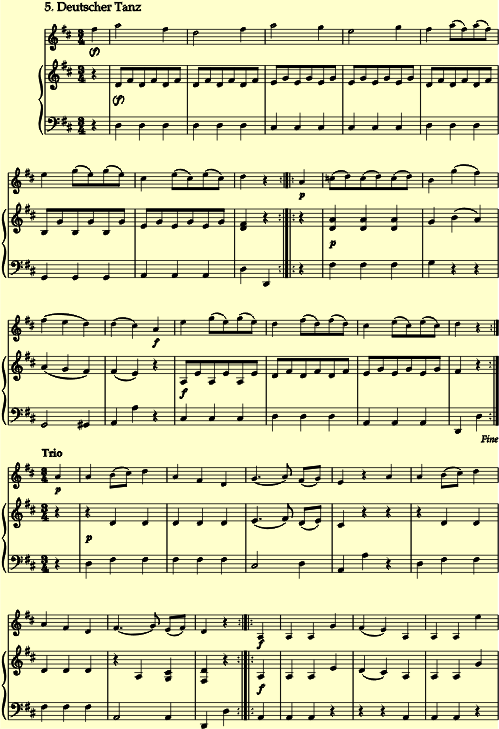WOLFGANG
AMADEUS
MOZART
DEUTSCHE
TÄNZE
SALZBURGER MENUETTE
LÄNDLERISCHE TÄNZE
für Violine und
Klavier
GERMAN DANCES
MENUETS
LAENDLER DANCES
for Violin and
Piano

DANSES CHAMPÊTRES
pour Violon et Piano
DANZE
TEDESCHE - MINUETTI
DANZE CHAMPESTRI
per Violono e Piano






Alle Stücke sind auch für weniger Geübte erreichbar.
Mozart, Haydn, Beethoven, Schubert und andere Meister, haben ihre Tanzstücke
für verschiedene Instrumente geschrieben. Sie haben sich auch an den Erfordernissen
der Praxis orientiert. Neben dem Satz für 2 Violinen und Baß gibt es Sätze
für verschiedene Blasinstrumente oder nur für Tasteninstrument. Wir dürfen
getrost annehmen, daß auch die großen Meister gelegentlich freizügig mit
der Besetzung umgingen und sich den Gegebenheiten des Augenblicks angepaßt
haben. Wir rechnen also damit, daß sie ais dem Olymp freundlich auf uns
blicken, wenn wir ihre kleinen Meisterwerke unseren Gegebenheiten anpassen.
Die vorliegende Ausgabe erscheint in 4 Varianten für ein Melodieinstrument
(Violine, Viola, Flöte oder Klarinette in B) und Klavier. Die Klavierstimme
ist vorwiegend zweistimmig gehalten, sodaß sie auch von zwei Melodieinstrumenten,
z.B. Violine und Violoncello ausgeführt werden kann. Auf einen wissenschaftlichen
Qellennachweis erlauben wir uns zu verzichten. Wir nehmen an, daß dieser
kaum genutzt würde. Einziges Ziel dieser Ausgabe ist es, Lust und Freude
am Musizieren zu wecken. Natürlich muß unsere Reihe mit Mozart beginnen.
Als der kleine Knirps von 6 Jahren anfing Musik aufzuschreiben, hat er
Menuette komponiert. Sein Vater Leopold, ein besonders guter Lehrer, hat
seinen Buben über Tanzstücke an das Komponieren herangeführt. Tänze erfordern
rhythmische Genauigkeit und deutliche periodische Gliederung - eine Anforderung,
die auch für die Ausführung großer Kompositionen bestehen bleibt. Das
heißt aber nicht, Tanzstücke seien nur Lehrstücke für Anfänger. Mozart
hat bis zum Ende seines Lebens immer wieder Tanzmusik geschrieben. Bei
Hofbällen, Redouten und anderen Festen haben die Zeitgenossen nach seiner
Musik das Tanzbein geschwungen. In seiner "Encyclopädie der schönen Künste"
von 1799 gibt Johann Georg Sulzer allen Musikern den Rat, sich nur ja
recht intensiv mit den Tanzstücken der verschiedenen Völker zu beschäftigen.
Auch nach 200 Jahren ist das immer noch ein guter Rat.
All pieces can be mastered by young at a medium
level of practice. Mozart, Haydn, Beethoven, Schubert and other celebrities
wrote their dance music for varying instrumentation, according to the
needs of everyday´s practice. Apart from the piece for two violins and
basse there are others for various wind or brass instruments or for one
keyboard instrument only. We can confidently assume that also the composers
too, handled the instrumentation they had originally defined rather freely,
adapting it to the requirements of the moment. Thus today we count on
their casting kind looks upon us from their Olympus when we also consider
our needs when playing those little masterpieces. This issue is introduced
in four versions, each featuring one melody instrument (violin, viola,
flute, clarinet in B flat) and piano. The piano score is basically set
in two voices such that it can also be played by two melody instruments
(e.g. violin and cello). We take the liberty to refrain from indicating
any scientific source as we do not assume it would be made use of. The
one and only aim of this issue is to arise childrens´ joy and pleasure
in music and playing it themselves. Naturally our little sequence must
start with Mozart. When the six-year-old little man began writing music
on a piece of paper the result was his first menuet. His father, being
an exceptionally gifted teacher, had guided his son to composing by using
dance pieces as examples. Dances call for rhythmic accuracy and clear
periodic structures - features that great symphonic works require in exactly
the same way. However, this does not imply that dances are mere practising
means for beginners. All his life Mozart frequently wrote dance music.
On the occasion of court balls, redoutes and other festivities , Mozart´s
contemporaries would shake a leg to his music. In his "Encyclodädie der
Schönen Künste" (Encyclopedia of the Fine Arts) of 1799 Johann Georg Sulzer
strongly recommends that all musicians thouroughly study the dance music
of the various nations. Even after 200 years this is a good piece of advice.
Fenster schließen
- Close Window - Fermer la fenêtre - Chiudi la finestra